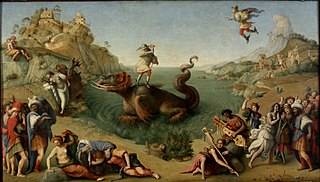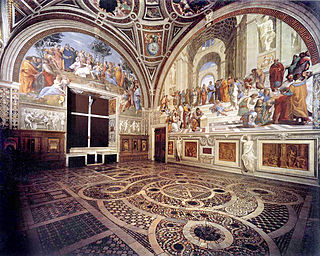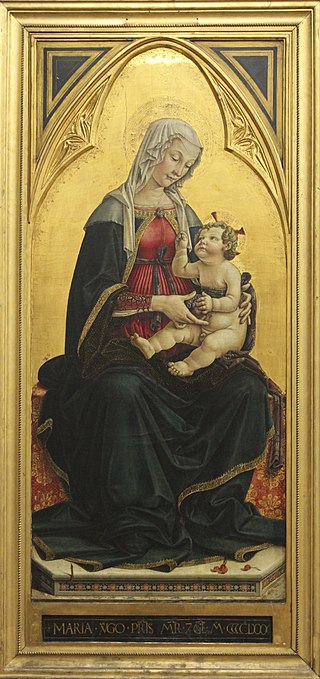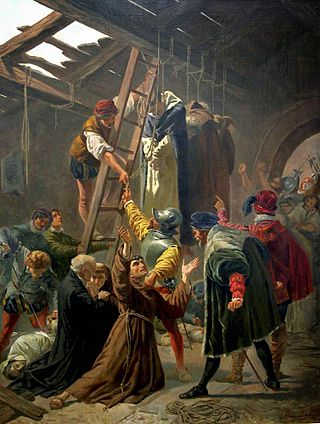
Bernardino of Siena, OFM, was an Italian Catholic priest and Franciscan missionary preacher in Italy. He was a systematizer of scholastic economics.

Luca Signorelli was an Italian Renaissance painter from Cortona, in Tuscany, who was noted in particular for his ability as a draftsman and his use of foreshortening. His massive frescos of the Last Judgment (1499–1503) in Orvieto Cathedral are considered his masterpiece.

Orvieto is a city and comune in the Province of Terni, southwestern Umbria, Italy, situated on the flat summit of a large butte of volcanic tuff. The city rises dramatically above the almost-vertical faces of tuff cliffs that are completed by defensive walls built of the same stone.

Piero di Cosimo, also known as Piero di Lorenzo, was an Italian Renaissance painter, who continued to use an essentially Early Renaissance style into the 16th century.

Pinturicchio, or Pintoricchio, also known as Benetto di Biagio or Sordicchio, was an Italian Renaissance painter. He acquired his nickname because of his small stature and he used it to sign some of his artworks that were created during the fifteenth and sixteenth centuries.

The four Raphael Rooms form a suite of reception rooms in the Apostolic Palace, now part of the Vatican Museums, in Vatican City. They are famous for their frescoes, painted by Raphael and his workshop. Together with Michelangelo's Sistine Chapel ceiling frescoes, they are the grand fresco sequences that mark the High Renaissance in Rome.

Girolamo Genga was an Italian painter and architect of the late Renaissance, Mannerist style.

The Brancacci Chapel is a chapel in the Church of Santa Maria del Carmine in Florence, central Italy. It is sometimes called the "Sistine Chapel of the early Renaissance" for its painting cycle, among the most famous and influential of the period. Construction of the chapel was commissioned by Felice Brancacci and begun in 1422. The paintings were executed over the years 1425 to 1427. Public access is currently gained via the neighbouring convent, designed by Brunelleschi. The church and the chapel are treated as separate places to visit and as such have different opening times and it is quite difficult to see the rest of the church from the chapel.

Orvieto Cathedral is a large 14th-century Roman Catholic cathedral dedicated to the Assumption of the Virgin Mary and situated in the town of Orvieto in Umbria, central Italy. Since 1986, the cathedral in Orvieto has been the episcopal seat of the former Diocese of Todi as well.
Events from the year 1553 in art.

The Sassetti Chapel is a chapel in the basilica of Santa Trinita in Florence, Italy. It is especially notable for its frescoes of the Stories of St. Francis, considered Domenico Ghirlandaio's masterwork.

Piermatteo de' Manfredi da Amelia was an Italian painter of the Renaissance period.
The Signorelli parapraxis represents the first and best known example of a parapraxis and its analysis in Freud's The Psychopathology of Everyday Life. The parapraxis centers on a word-finding problem and the production of substitutes. Freud could not recall the name (Signorelli) of the painter of the Orvieto frescos and produced as substitutes the names of two painters Botticelli and Boltraffio. Freud's analysis shows what associative processes had linked Signorelli to Botticelli and Boltraffio. The analysis has been criticised by linguists and others.

The Testament and Death of Moses is a fresco attributed to the Italian Renaissance painters Luca Signorelli and Bartolomeo della Gatta, executed in around 1482 and located in the Sistine Chapel, Rome.

Cesare Fracassini was an Italian painter, mainly of large mythologic or religious topics.

Palazzo del Magnifico, also known as Palazzo Petrucci, built as the residence of Pandolfo Petrucci, is located in Siena on Piazza San Giovanni at the corner of Via dei Pellegrini.

Allegory of Fertility and Abundance is a allegorical tempera on panel painting by Luca Signorelli, created c. 1500, now in the Uffizi in Florence. Produced around the same time as the artist's frescoes in the San Brizio Chapel in Orvieto, the work is a monochrome allegory inspired by classical bas-reliefs and intended for a humanist scholar's studiolo. Its figures refer to the artist's nudes in his frescoes at Orvieto and Madonna and Child with Ignudi.

Adoration of the Magi is a painting in tempera on wood panel by Luca Signorelli (1450–1523) and his assistants, executed c. 1493–1494, and now in the Louvre in Paris. It was probably the first painting he produced in Città di Castello, and originally hung over the main altar of the monastery church of Sant'Agostino. The surface displayed within the frame is 331 cm by 245.5 cm. In late 2022 it was not on display.

Lamentation over the Dead Christ is a painting of 1502 in oils on panel by Luca Signorelli, painted for the church of Santa Margherita and now in the Diocesan Museum in Cortona. In the left background is the Crucifixion and in the right background the Resurrection.

Saint Anthony Preaching to the Fish is a 1580–1585 oil-on-canvas painting of Anthony of Padua by Paolo Veronese, now in the Galleria Borghese in Rome. Its original location is unknown, though its medium dimensions of 104 centimetres (41 in) by 150 centimetres (59 in) mean it may have been painted for the side wall of a chapel or as part of a cycle of paintings for a small school (scuola) somewhere in Veneto. It entered the collection of Cardinal Scipione Borghese as a 1607 gift from Francesco Barbaro.



















